|
By dodg66440 - 12 Years Ago
|
|
A few months back I purchased a nice 56 Customline that started life a 6 cyl. car. Somewhere along the way it had a 57 motor installed. In the trunk was an ECG 9424-D intake with 2 teapot carbs installed. The block is a ECZ-6015B. Is it possible this is an E code motor? Or just something someone threw together? Thanks for any insight.
|
|
By Daniel Jessup - 12 Years Ago
|
|
do you know if the 57 motor is a 312? If it isn't a 312 then it is a 292. (Ford used the ECZ block stamp for 292's and 312's, so you are going to have to look at the crank flange or drop the oil pan to confirm) If it is a 312 then there is a good possibility that the 57 engine might be an "E Code" engine, but then you would wonder why the previous owner would not installed it with the car. Most of the time the extra parts are things that owners accumulate in hopes of one day installing it on their vehicle.
|
|
By dodg66440 - 12 Years Ago
|
|
The previous owner bought the car with the dual quad setup installed. He had it removed and installed a 57 single 4bbl intake with a 600 cfm edelbrock. because he wasn't happy with the way it ran. I'm going to pull the motor over the winter to detail the engine compartment and reseal the engine. I'll find out if it's a 312 when I pull the pan. Thanks for the input.
|
|
By slumlord444 - 12 Years Ago
|
|
In answer to your original question. As stated it is possible to identify it as a 312. To my knowledge there is no way to positively identify it as being an original E engine. If it has the E valley pan, fuel filter and any other original E parts other than the intake in the trunk, there is a good possibility that it could have been an E engine. Still no way to prove that the block was an E that I am aware of.
|
|
By dodg66440 - 12 Years Ago
|
Supercharged, thanks for the info on distributor id. Next question, what makes an E valley pan unique?
Thanks,
Bruce Martin
|
|
By NoShortcuts - 12 Years Ago
|
Dan and Slumlord's points are good ones. First, determine if the engine is a 312. Only 312s came from the factory with the 'E' set-ups. Next, determine how many of the 'E' components you've got. When these set-ups get moved around from vehicle-to-vehicle, often some items are forgotten.
Slumlord mentioned the valley pan and fuel filter canister. Another less obvious component that should have been moved is the distributor. The serial number on the housing of the 'E' is unique. The different number was assigned because the 'E' distributors' have a different secondary spring in the centrifugal advance mechanism to produce a different advance curve. Also, different shims were used in the 'E' distributors' vacuum advance canister to compensate for the reduced vacuum signal produced when there are two carbs feeding the engine.
1957 Ford dual quad distributor serial numbers:
FEH 12127-C passenger car 'E' code
FEJ 12127-B 'Bird 'E' code w/ tach drive unit
Other '57 Ford distributor numbers
- FEH 12127-A 292 passenger
- FEK 12127-A 312 passenger
- FEH 12127-E 312 passenger - supercharged only - dual points
- FEJ 12127-A 292/312 'Bird - w/ tach drive unit
- FEK 12127-B 312 'Bird - w/ tach drive unit
- FEJ 12127-D 312 'Bird - supercharger only - dual points - w/ tach drive unit
Hope this helps!
|
|
By NoShortcuts - 12 Years Ago
|
The valley pan most associated with being from a '57 'E' has a concave flat section to permit the mounting of the aluminum intake on the cylinder heads.
Some say that there were some early production '57 'E' engines that used the late '56 Ford model year, over-the-parts-counter-only, 2x4 power pack application only, flat valley pans. Some argue about this stuff... 
If you go to eBay motors and use their search function, search for item 3310770277519. This is a quality reproduction. NOTE: When eBay item 310770277519 opens, toggle the 'sold' picture, then scroll down the page to see the original listing and the pictures that are part of the seller's description.
Another repo Ford 2x4 valley pan that is presently listed on eBay is item number 350857983663
None of the usually identified as '57 'E' style concave flat section valley pans are presently listed on 'E' bay and I don't have a picture to post.
Regards,
|
|
By dodg66440 - 12 Years Ago
|
Charlie,
Thanks for all the info. Looks like I need to get out in the garage and do a little investigating.
Regards,
Bruce
|
|
By Ted - 12 Years Ago
|
|
You might also look at the Teapot carb numbers. For the ECG-D manifold, the Holley list numbers on the back flange of the carb are expected to be 1434 and/or 1437. If the carbs numbers are correct, then the carbs facing forward or rearward will be clue to if the intake came off of Thunderbird or car/Ranchero/station wagon. If the carbs are facing the rear, there should be a bellcrank between the carbs to move the throttle linkages to the passenger side of the engine.
|
|
By yalincoln - 12 Years Ago
|
|
you might want to check the cam when you dismantle the engine, the E code used a different cam.
|
|
By NoShortcuts - 12 Years Ago
|
Hmmm... Here's another thing I've been told is a component of the original 'E' code 312 engine...
The valve spring assemblies on ALL '57 'E' code and 'F' code engine cylinder heads are different than all other '57 y-block offerings.
When you take the valve covers off, look for:
- single valve springs w/ an inner damper (no damper on all others)
- one piece steel valve spring retainers (not the usual two piece style)
The valve spring retainers (by my understanding) look like the retainers presently available on eBay motors. Use the eBay search function to display item number 331006615876
There are other regulars on this Forum like Oldmics who should be able to confirm this for you.
Hope this helps! 
|
|
By Oldmics - 12 Years Ago
|
Charlie
While your parts information is accurate,you have the applications turned around.
The extra parts you describe only were installed on the DSO engines from the factory.
The normal 270 H.P "E" code engines did not received this treatment.The 285 H.P. "E" code engines are believed to have received the beefed up valve train and the broached heads.
The regular 300 H.P. blower engine did not receive the upgraded valve train, only the optional camshaft DSO engine got the heavy duty parts.
The exception to the rule would be IF the parts were dealer installed as per a TSB that was put out.
As you have previously mentioned "some will argue about this".
Oldmics
|
|
By NoShortcuts - 12 Years Ago
|
Thanks for coming in on this, Oldmics. What you've indicated in your entry makes much more sense to me.
My understanding has been that the '57 'C', 'D', and lower horsepower 'E' codes all used the same camshaft.
Using different valve springs and valve spring retainers doesn't seem like something that would have been purposeful.
Thanks for setting this straight. I know that you've dug into the 'E's, 'F's, the performance Mercs, and the FoMoCo camshaft nuances of this era extensively.
Regards,
|
|
By Robs36Ford - 12 Years Ago
|
Valley Pan. Look at my profile Pic.
Cannot find it on the net but I had saved this pic.
I have the underside pic too but I guess there is no photo support on this blog.
|
|
By NoShortcuts - 12 Years Ago
|
|
NoShortcuts (11/24/2013)
The valley pan most associated with being from a '57 'E' has a concave flat section to permit the mounting of the aluminum intake on the cylinder heads.
None of the usually identified as '57 'E' style concave flat section valley pans are presently listed on 'E' bay and I don't have a picture to post.
Thanks for your posting, Rob.
Currently there is a listing on eBay that will provide an enlarged view of what appears to be an original '57 Ford 'E' valley pan. If you go on the Internet to eBay Motors and use their search function, search for item 350953273855.
If not stated previously in this thread, attempting to install a '56 or '57 Ford made dual quad intake manifold in conjunction with a standard '54 - '64 Ford production y-block valley pan cover is likely why a used manifold may have required aluminum welding to repair the mounting flange 'ears' adjacent to the water passageways at the front of the intake on either side of the thermostat housing.
|
|
By Oldmics - 12 Years Ago
|
While the recessed valley pan was a necessary part for the "E" code engines, it was also installed on a fair amount of "C" engines from the factory.
The recessed pans have been found on quite a few "C" Birds.
So gotta be carefull on going with the valley pan identification, you might end up with a 292 with a cool valley pan.
Oldmics
|
|
By pegleg - 12 Years Ago
|
Charlie, I think Oldmics is correct. All the 57's apparently used the same cam and springs, (including the F codes) unless the optional cam was installed with the matching springs. The 285 Hp or 340 hp F code figures were never released by Ford, but invented by the aftermarket or sanctioning bodies. I'm not sure if the Stage 1 (Daytona) E/F Codes used the standard or an optional cam. But the factory built Stage 2's were sold with the regular production cam.
In the case of the F code it was NHRA I think, while the 285 number was probably an AMA, USAC, or Nascar number.
That should start some more discussion! 
|
|
By Oldmics - 12 Years Ago
|
Frank
There is a mention in Ford documentation specifically about a 285 H.P. "E" code engine as well as the mention of the standard 270 H.P. engine.
So Ford does admit/claim that they produced such a power plant. But that's about all they say about it!
Oldmics
|
|
By Ol Ford Guy - 12 Years Ago
|
|
My E Code heads have inner valve spring dampers with the standard cam. Jerry Ponder said his E Code cars had the inner dampers too.
|
|
By PF Arcand - 12 Years Ago
|
|
Paul J; Ford apparenty realized that they had a problem with with the non DSO, E & F code engines at some point. In Eickman's Y-Blk book, page 105, there is reference to a TSB with conversion parts. It included a different spring and damper assembly & push rod & retainer. They realized late, that running the standard valve train over 5500 rpm risked dropping a valve!
|
|
By Ted - 12 Years Ago
|
Here are some pics of valley covers for the Ford dual quad intake manifolds. The first picture is a homemade unit while the second and third pics are the factory recessed covers for a ’57 Ford E code.



|
|
By Ted - 12 Years Ago
|
In support of what John brings up regarding documentation, here is an excerpt from a memo sent to dealers late in 1956 regarding the supercharged, 270HP, and 285HP engines.
Because of the imminence of this new supercharged engine, it has been decided to discontinue the 285 horsepower engine effective immediately. We will continue to offer the 270 horsepower engine until such time as the supercharged engine supply is increased to a level permitting the phase-out of the 270 horsepower engine. During the interim, both engines will be offered.
As of this date approximately1,000 – 270 horsepower engines have been assembled, with 1,000 more to be assembled by January 1, 1957 and an additional 1,700 more to be assembled by February 1, 1957. …
And here’s another excerpt from some literature also listing the 270 and 285 horsepower engines.

|